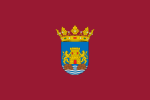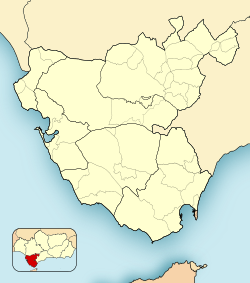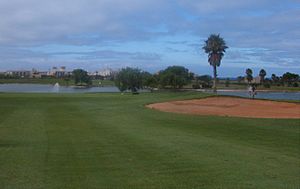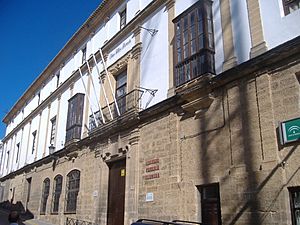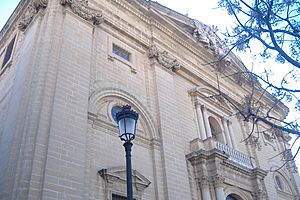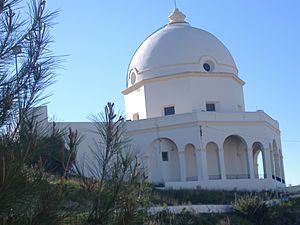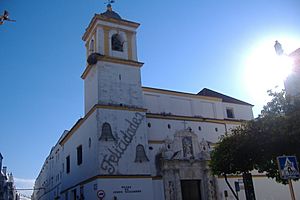Chiclana de la Frontera facts for kids
Quick facts for kids
Chiclana de la Frontera
|
|||
|---|---|---|---|

|
|||
|
|||
| Country | |||
| Autonomous community | |||
| Province | Cádiz | ||
| Comarca | Bay of Cádiz | ||
| Commonwealth | Municipios de la Bahía de Cádiz | ||
| Area | |||
| • Total | 205.45 km2 (79.32 sq mi) | ||
| Elevation | 11 m (36 ft) | ||
| Population
(2018)
|
|||
| • Total | 83,831 | ||
| • Density | 408.036/km2 (1,056.81/sq mi) | ||
| Demonym(s) | Chiclaneros | ||
| Time zone | UTC+1 (CET) | ||
| • Summer (DST) | UTC+2 (CEST) | ||
| Postal code |
11130
|
||
| Dialing code | 956 | ||
Chiclana de la Frontera is a lively town in southwestern Spain. It is located in the province of Cádiz, in the region of Andalucía, close to the Gulf of Cádiz. This town is part of a group of cities in the Bay of Cádiz. This area forms one of the largest city regions in Andalusia.
Chiclana is about 20 kilometers (12 miles) southeast of the city of Cádiz. It shares borders with San Fernando and Puerto Real to the north. To the south, it borders Conil de la Frontera. In 2012, about 81,473 people lived here. The town covers an area of 203 square kilometers (78 square miles). Its average height is 11 meters (36 feet) above sea level.
The town's economy relies a lot on modern industries. Salt processing and tourism are very important. Chiclana is famous for its beautiful beaches. One popular beach is the 6-kilometer (3.7 miles) long Playa de la Barrosa. The area also has many hotels and golf courses, especially in the Novo Sancti Petri resort. Chiclana has the most hotel beds in the Province of Cádiz.
Contents
History of Chiclana
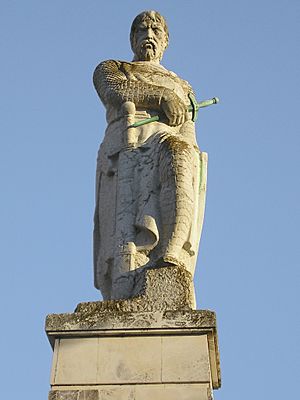
People have lived in the Chiclana area for a very long time. Evidence shows humans were here during the Paleolithic (Stone Age) period. Several villages from the Neolithic era have been found.
Ancient people like the Phoenicians settled near the town. They built a temple on a small island called Islote de Sancti Petri. When the Romans arrived, they used this temple for their god Hercules. Old items from the Phoenicians, Carthaginians, and Romans have been found here. You can see them in the Museum of Cádiz.
In 1303, Christian armies entered the town. They were led by Alonso Pérez de Guzmán. The Moors, who had lived in Southern Spain since the 8th century, had left the area. Guzman claimed these lands for the Kingdom of Castille.
A famous battle, the Battle of Barrosa, happened near Chiclana. This was on March 5, 1811. The French army was defeated by an army from Britain and Spain. This battle was part of the Spanish War of Independence. In the early 1900s, workers from Portugal came to Chiclana. They helped with the cereal fields.
Geography and Climate
Chiclana de la Frontera is on the Costa de la Luz (Coast of Light). This is on the southern coast of Spain. The town is in the southwest of the province of Cádiz. It borders Puerto Real to the north and San Fernando to the northwest. To the south, it borders Conil de la Frontera.
The town is about 20 kilometers (12 miles) from the city of Cádiz. Several small villages are part of the municipality. These include La Coquina, La Barrosa, and Novo Sancti Petri.
The coastline has long, beautiful beaches. The most important is La Barrosa, which is 6 kilometers (3.7 miles) long. Other beaches include Sancti Petri and El Puerco. The highest point in the area is Cerro del Aguila, at 52.3 meters (171.6 feet) above sea level. Another important hill is Cerro de Santa Ana, at 49.8 meters (163.4 feet).
The River Iro flows through Chiclana. It starts in Lago Salado and flows into the Bay of Sancti Petri. The land is mostly flat but has gentle hills.
Chiclana has a typical climate for Spain's southern Atlantic coast. It is often humid. The average temperature is around 19°C (66°F). In August, it can reach 30°C (86°F). In January, temperatures can drop to 2°C (36°F). The town gets about 3,000 hours of sunshine each year.
The average rainfall is about 600 mm (24 inches) per year. December is usually the wettest month. Summers are very dry. Sometimes, the town can get heavy rain, which might cause flooding. The area has many pine, olive, and oak trees. There is also a forest park called "Pinar del Hierro y de la Espartosa." This park is popular for hiking and mountain biking.
Economy and Industry
Long ago, Chiclana was known for making clay pots called amphorae. These were used to carry fish sauce. In the 1800s, the town made linen and pottery. Today, the economy is mostly about modern industries.
Salt processing and tourism are very important. Chiclana is famous for its long, sandy beaches like Playa de la Barrosa. The resort of Novo Sancti Petri has many hotels and golf courses. Chiclana has the most hotel rooms in the entire province of Cádiz. There are about 20 luxury hotels, mostly four or five stars.
Some famous golf courses include the 36-hole Club de Golf Novo Sancti Petri. The Playa de la Barrosa beach also has many restaurants and shops. In the town center, you can find a busy market. Here, people sell fresh fruits, vegetables, fish, and meat.
Besides salt, Chiclana is also a center for making furniture. You can find many furniture stores along Avenida de los Descubrimientos.
The land around Chiclana is very fertile. This means it's great for farming, especially for vineyards. Wine has been made here for centuries. It became very important in the 1500s when trade with America grew. More land was used to grow grapes for wine to be sent to other countries. The wine industry was biggest in the 1800s.
Today, Chiclana has many wineries. They make fine wines like fragrant and muscatel types. Tourists often visit these wineries. The town is known for its sherry wines. Chiclana de la Frontera is considered one of the world's best wine-producing areas.
Main Sights to See
Chiclana has many interesting places to visit.
Towers of Chiclana
There are three important towers in the area:
- The Torre del Puerco is from the 1500s. It was used as a defense spot during the Battle of Barrosa in 1811.
- The Torre Bermeja is another old defense tower. It stands on the Playa de la Barrosa beach.
- The Torre del Reloj (Clock Tower) is a famous building in Chiclana. It is in the Plaza Mayor (Main Square). It was built in the 1700s on top of an old town gate. It has four parts and a bell tower. The tower is even mentioned in a poem!
Historic Buildings
The old part of the city has many beautiful buildings. These include neoclassical buildings and grand houses from the 1700s. They belonged to rich families who made money from trade with America.
- The Plaza Mayor is the oldest public square in Chiclana. It was the center of the town for many centuries.
- Casa Briones, also in Plaza Mayor, is a great example of 1700s architecture. Today, it is home to the Museo de Chiclana.
- The Town Hall (Casa Consistorial) was originally built in the 1700s. A new, modern building was opened in 2011. It kept some parts of the old building, like the main front and a grand staircase.
Castles and Palaces
- The Castillo de Sancti Petri is a castle built in the Moorish style in the 1200s. It is now in ruins but is still impressive.
- The Casa-palacio del Conde de Torres is a mansion from the 1700s. It mixes neoclassical and baroque styles. Part of its garden is now a public park.
- The Casa-palacio del Conde del Pinar is another palace from the 1700s. It shows a mix of neoclassical and baroque styles. It has a grand stone front and a courtyard inside. Today, the government uses it for cultural events.
Churches of Chiclana
- The Capilla del Santo Cristo (Chapel of the Holy Christ) is the oldest religious building in Chiclana. It dates back to the late 1400s.
- The Iglesia de San Sebastián is from the 1500s. It has been rebuilt many times.
- The Convento de Jesús Nazareno is a beautiful baroque church from the 1600s.
- The Iglesia de San Juan Bautista (Main Church) is a masterpiece of neoclassical design from the 1700s. It has valuable carvings and paintings. It has been a protected cultural monument since 1975.
- The Ermita de Santa Ana was built in 1771. It is on the highest point in the city. This octagonal chapel offers amazing views for miles around.
Culture and Traditions
Museums to Explore
- The Museo de Chiclana is in the Casa de los Briones. Here, you can learn about the town's history, from ancient times to today. It has sections on wine, farming, salt, and fishing. There are also videos that explain Chiclana's traditions.
- The Museo Municipal Taurino Francisco Montes is dedicated to Francisco Montes Reina, a famous bullfighter born in Chiclana in 1805.
- The Wine and Salt Museum opened in 2016. It teaches visitors about Chiclana's important wine and salt industries.
Fun Festivals
Chiclana de la Frontera celebrates many colorful festivals throughout the year.
- Carnaval happens at the start of Lent. It includes a big parade and fun performances.
- The San Antonio Fair is in mid-June. There's a parade, dancing, and women often wear traditional costumes.
- Corpus Christi features streets decorated with rosemary, incense, and altars. There's also a religious procession.
- The Festival of Parpuja in August celebrates flamenco music. Famous flamenco singers perform, and traditional foods and local wines are enjoyed.
There are also many feast days that celebrate Catholic traditions:
- The Feast of San Juan Bautista is on June 23–24. It includes a procession with brass bands.
- The Feast of Our Lady of Mount Caramel is on July 16. A statue of the Virgin del Carmen Barrosa is carried in a procession.
- The Feast of Santa Ana is on July 26. There's a procession and festivities around the saint's shrine.
- The Feast of Our Lady of Remedies is on September 8. This day honors the patron saint of the city. It also marks the start of the grape harvest with a traditional grape pressing.
Notable People from Chiclana
- Antonio Alemania, a singer and songwriter.
- Antonio García Gutiérrez, a poet and playwright.
- Sebastián Gessa y Arias (1840–1920), a painter.
- Fernando Quiñones, a writer.
- Juan Álvarez Mendizábal, who was a Minister of Finance and a former Prime Minister of Spain.
- Francisco Montes Reina, a famous bullfighter.
- José Manuel Moreno (cyclist), an Olympic champion cyclist from 1992.
Twin Towns
Chiclana de la Frontera has special friendships with other towns:
 El Astillero, Spain
El Astillero, Spain Béziers, France
Béziers, France
See also
 In Spanish: Chiclana de la Frontera para niños
In Spanish: Chiclana de la Frontera para niños


